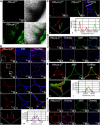A diverse member of the fungal Avr4 effector family interacts with de-esterified pectin in plant cell walls to disrupt their integrity
- PMID: 33962956
- PMCID: PMC8104879
- DOI: 10.1126/sciadv.abe0809
A diverse member of the fungal Avr4 effector family interacts with de-esterified pectin in plant cell walls to disrupt their integrity
Abstract
Effectors are small, secreted proteins that promote pathogen virulence. Although key to microbial infections, unlocking the intrinsic function of effectors remains a challenge. We have previously shown that members of the fungal Avr4 effector family use a carbohydrate-binding module of family 14 (CBM14) to bind chitin in fungal cell walls and protect them from host chitinases during infection. Here, we show that gene duplication in the Avr4 family produced an Avr4-2 paralog with a previously unknown effector function. Specifically, we functionally characterize PfAvr4-2, a paralog of PfAvr4 in the tomato pathogen Pseudocercospora fuligena, and show that although it contains a CBM14 domain, it does not bind chitin or protect fungi against chitinases. Instead, PfAvr4-2 interacts with highly de-esterified pectin in the plant's middle lamellae or primary cell walls and interferes with Ca2+-mediated cross-linking at cell-cell junction zones, thus loosening the plant cell wall structure and synergizing the activity of pathogen secreted endo-polygalacturonases.
Copyright © 2021 The Authors, some rights reserved; exclusive licensee American Association for the Advancement of Science. No claim to original U.S. Government Works. Distributed under a Creative Commons Attribution NonCommercial License 4.0 (CC BY-NC).
Figures








Similar articles
-
Cladosporium fulvum Avr4 protects fungal cell walls against hydrolysis by plant chitinases accumulating during infection.Mol Plant Microbe Interact. 2006 Dec;19(12):1420-30. doi: 10.1094/MPMI-19-1420. Mol Plant Microbe Interact. 2006. PMID: 17153926
-
Structure of the Cladosporium fulvum Avr4 effector in complex with (GlcNAc)6 reveals the ligand-binding mechanism and uncouples its intrinsic function from recognition by the Cf-4 resistance protein.PLoS Pathog. 2018 Aug 27;14(8):e1007263. doi: 10.1371/journal.ppat.1007263. eCollection 2018 Aug. PLoS Pathog. 2018. PMID: 30148881 Free PMC article.
-
The chitin-binding Cladosporium fulvum effector protein Avr4 is a virulence factor.Mol Plant Microbe Interact. 2007 Sep;20(9):1092-101. doi: 10.1094/MPMI-20-9-1092. Mol Plant Microbe Interact. 2007. PMID: 17849712
-
Fungal effector proteins.Annu Rev Phytopathol. 2009;47:233-63. doi: 10.1146/annurev.phyto.112408.132637. Annu Rev Phytopathol. 2009. PMID: 19400631 Review.
-
Fungal chitinases: function, regulation, and potential roles in plant/pathogen interactions.Curr Genet. 2016 May;62(2):243-54. doi: 10.1007/s00294-015-0530-x. Epub 2015 Nov 2. Curr Genet. 2016. PMID: 26527115 Review.
Cited by
-
Metatranscriptomics captures dynamic shifts in mycorrhizal coordination in boreal forests.Proc Natl Acad Sci U S A. 2022 Jun 28;119(26):e2118852119. doi: 10.1073/pnas.2118852119. Epub 2022 Jun 21. Proc Natl Acad Sci U S A. 2022. PMID: 35727987 Free PMC article.
-
Fungal Effectoromics: A World in Constant Evolution.Int J Mol Sci. 2022 Nov 3;23(21):13433. doi: 10.3390/ijms232113433. Int J Mol Sci. 2022. PMID: 36362218 Free PMC article. Review.
-
Progress in pathogenesis research of Ustilago maydis, and the metabolites involved along with their biosynthesis.Mol Plant Pathol. 2023 May;24(5):495-509. doi: 10.1111/mpp.13307. Epub 2023 Feb 17. Mol Plant Pathol. 2023. PMID: 36808861 Free PMC article. Review.
-
Evasion of plant immunity by microbial pathogens.Nat Rev Microbiol. 2022 Aug;20(8):449-464. doi: 10.1038/s41579-022-00710-3. Epub 2022 Mar 16. Nat Rev Microbiol. 2022. PMID: 35296800 Review.
-
Recent Advances in Understanding the Roles of Pectin as an Active Participant in Plant Signaling Networks.Plants (Basel). 2021 Aug 19;10(8):1712. doi: 10.3390/plants10081712. Plants (Basel). 2021. PMID: 34451757 Free PMC article. Review.
References
-
- Jones J. D. G., Dangl J. L., The plant immune system. Nature 444, 323–329 (2006). - PubMed
-
- Bacete L., Mélida H., Miedes E., Molina A., Plant cell wall-mediated immunity: Cell wall changes trigger disease resistance responses. Plant J. 93, 614–636 (2018). - PubMed
-
- De Lorenzo G., Ferrari S., Giovannoni M., Mattei B., Cervone F., Cell wall traits that influence plant development, immunity, and bioconversion. Plant J. 97, 134–147 (2019). - PubMed
-
- Caffall K. H., Mohnen D., The structure, function, and biosynthesis of plant cell wall pectic polysaccharides. Carbohydr. Res. 344, 1879–1900 (2009). - PubMed
Publication types
MeSH terms
Substances
LinkOut - more resources
Full Text Sources
Other Literature Sources
Miscellaneous

